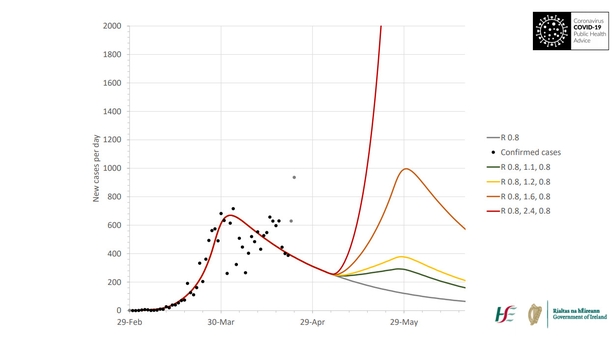There are two key things that health officials need to know before there can be any change in current restrictions around Covid-19.
The first is that the disease needs to be at a very low level.
They also need to be assured that we as a population can keep the reproduction rate of the virus at or below 1, and that we can take measures to drive it below 1 if necessary.
The man leading the expert modelling team guiding public health officials presented a very positive picture of where this virus now stands.
Professor Philip Nolan said there has been a "very significant suppression of the growth of Covid-19 and the transmission of it".
Growth rate
In the middle of March, the growth rate in the number of new cases stood at around 33%, meaning new cases were rising by a third every day.
This declined over March and April, and now Professor Nolan says that since the beginning of the month, the growth rate of new cases has been "effectively zero" and there has been "no growth in the disease for some weeks now".
Reproduction number

A presentation at the Department of Health's daily briefing also outlined how the reproduction number of the virus has fallen "significantly below 1" - that is the average number of people an infected person would spread the virus to.
Professor Nolan said there were four separate methods to estimate this number, and that all four confirm "with a high level of confidence" that it is now between 0.5 and 0.8.
He said this reduction is due to the work everyone has done to interrupt the transmission of Covid-19.
It also means that on average, if half the population gets the virus, they are not spreading it to anybody else.
The other half are transmitting it to only one other person.
Professor Nolan said this reflects an "extraordinary level of restraint".
But while both of these figures signal positive progress, Professor Nolan warned that we need to be "exceptionally careful" about what we do after 5 May.
Model projections
He presented mathematical models that outline what could happen if the reproduction number rises over one.
Professor Nolan said that if some restrictions are relaxed on 5 May, people maintain very strong physical distancing, and the number climbs just over 1, the number of cases will rise slowly.
But, he said, if restrictions are reimposed at this point, the disease can be brought back under control.
If the reproduction number were to rise even further to 1.2, reimposed measures three weeks after they were relaxed can control the disease.
An additional increase to 1.6 could bring a "dangerous peak" in cases.
Professor Nolan said this could be "perhaps up to 1,000 cases at peak" and would mean a lot more people in hospital and intensive care.
However, even at this dangerous level, the disease could still be suppressed by bringing back strict restrictions.
The projections show that the "real difficulty" comes if the reproductive number goes as high as 2.4.
"We wouldn't be able to cope with that, quite frankly," he said.
Professor Nolan said these kinds of model projections inform the "strong sense of whatever happens in the coming weeks, we need to be exceptionally cautious that we do nothing that promotes a higher level of transmission of the virus than we currently have".







